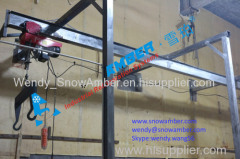




Snow Amber Block Ice Making Machine 5T
| Min. Order: | 1 Set/Sets |
|---|---|
| Payment Terms: | L/C, D/P, T/T |
| Supply Ability: | 8sets per month |
| Place of Origin: | Shanghai |
Company Profile
| Location: | Shanghai, China (Mainland) |
|---|---|
| Business Type: | Manufacturer, Trading Company, Agent, Distributor/Wholesaler |
| Main Products: | Ice Machine |
Product Detail
| Model No.: | SAB50 |
|---|---|
| Means of Transport: | Ocean, Air, Land |
| Category: | Ice Machine |
| Capacity Type: | Others |
| Certification: | CE |
| Brand Name: | Snow Amber |
| Model: | SAB50 |
| Capacity: | 5,000KG/24H |
| Refrigeration capacity: | 30.5kw |
| Total power: | 16.28kw |
| Power supply: | 380V-3P-50Hz |
| Ambient temperature: | 35DegC |
| Water inlet temperature: | 25DegC |
| Ice temperature: | -8 |
| Refrigerant: | R22/R404a/R407c |
| Condenser Cooling Way: | Air/Water/Evaporative cooling |
| Production Capacity: | 8sets per month |
| Packing: | Wooden Cases |
| Delivery Date: | 30 working days |
Product Description
SAB50 Capacity: 5.0 Tons daily block ice machine
| Model | - | SAB50 |
| Capacity | Ton/d | 5 |
| Refrigeration capacity | kW | 30.5 |
| Input power | kW | 16.28 |
| Rated current | A | 29.86 |
| Power supply | - | 380V-3P-50Hz |
| Ambient temperature | ℃ | 35 |
| Water inlet temperature | ℃ | 20 |
| Ice temperature | ℃ | -8 |
| Compressor power | kW | 15.35 |
| Refrigerant | - | R404A/R22 |
| Cooling way | - | Water cooling/Air cooling |
| condenser Capacity | kW | 46 |
| condenser water flow | M3/H | 7.912 |
| Cooling tower power | kW | 0.18 |
| Cooling pump power | kW | 0.75 |
| Power of cutter | kW | 0.75 |
| Chilling pump power | kW | 1.5 |
| All water consumption | M3/H | 0.287 |
| Size of ice maker | L×W×H mm | 7260×2200×2200 |
| Size of evaporator | L×W×H mm | Included in the unit |
| Operating weight | Kg | 4860 |
Brine pool block ice machine features
Ti pipe is used as evaporative coil to improve the heat transfer effect, and its stainlessness, anti-corrosion feature can guarantee the long service time.
PE material is adopted in the parts of thawing tank connecting the brine and fresh water and it is stainless and low temperature-resistant.
Unique design of ice thawing tank and ice dumping unit brings easier operation.
The thawing tank is heated by hot gas discharged from the compressor so that it is more energy saving and makes the ice maker more suitable for areas where water temperature is low.
Module design makes the ice maker easy to transport, move and install.
Every brine refrigeration block ice machine can be designed and produced according to your specific requirements.
The brine refrigeration block ice maker machine can be installed in 20ft or 40ft brand new container with other relevant equipments.
Brine block ice machine, block ice maker workflow:
1. Feeding water in ice moulds.
Lift up the lower seal plate to be fastened in the fixed handle and get the whole aluminum alloy plate sealed, and then add water in the ice cans to the standard water level.
2. Saltwater agitator makes the saltwater flow cyclically/ ice making process
The refrigerant will have water-heat exchanger in the ice cans through refrigerant runner to lower the water temperature and in a certain time, all the water in the ice can will turn into block ice.
3. Water in Ice moulds. frozen./ ice frozen finished
Saltwater in brine tank cooled with refrigeration system running and saltwater flow cycling, which makes the water in ice moulds frozen.
4. Melting block ice moulds.
When ice making is finished, open the lower seal plate manually and refrigeration system will change into doffing ice mode automatically in which HPHT refrigerant air will release heat in the refrigerant runner that will melt the surface of block ice in the ice cans.
5. Remove / harvest ice.
Damp the ice block from ice can with dumper, then store block ice
The Ice Making & Harvesting section of the plant consists of the Brine Tank, an electrically operated Lifting Device (Crane) running on rails along the sides of the tank, a Thawing Tank, a Tilting Device with an inclined Wooden Table to receive the ice blocks as they slide out of the cans and a Filler.
Block Ice Machine Application Fields
1. Ice factory at ports and docks;
2. Fresh preservation and cooling of aquatic products;
3. Fresh preservation of aquatic products and foods during line haul;
4. Temperature reduction and cooling in specific fields;
5. Ice sculpture;
6. Eible ice

